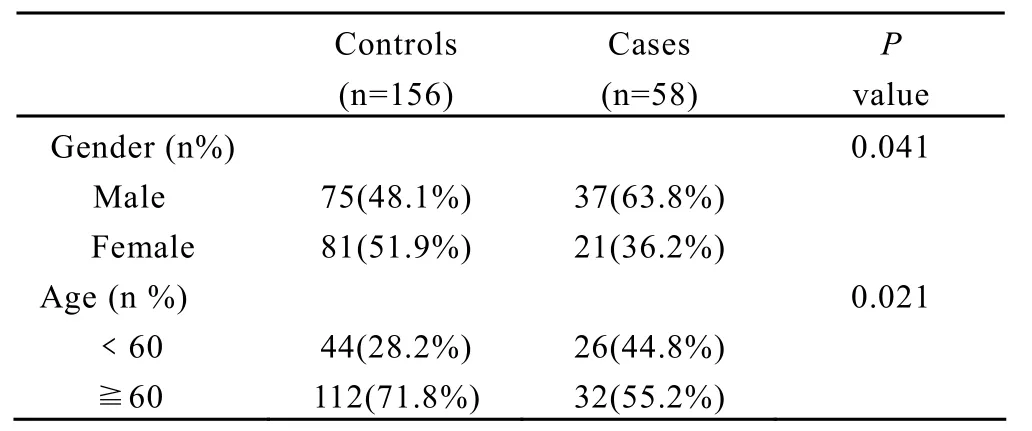Association of Lysosome Associated Protein Transmembrane 4 Beta Gene Polymorphism with the Risk of Pancreatic Cancer
2010-01-08ShanWangQingYunZhang
Shan Wang,Qing-Yun Zhang
Key Laboratory of Carcinogenesis and Translational Research(Ministry of Education),Clinical Laboratory,Peking University Cancer Hospital & Institute,Beijing 100142,China
INTRODUCTION
The prevalence of pancreatic cancer has increased dramatically over the past decades.Its mortality accounts for one fifth of the gastrointestinal cancers[1].The causes of pancreatic cancer remain unknown,and risk factors can be classified into three broad categories: demographic,environmental,and genetic predisposition[2].Despite recent diagnostic and therapeutic advances,pancreatic carcinoma still carries a poor prognosis,the overall 5-year survival rate among patients is <5%[3].So a tumor marker for early diagnosis is essential.
Recently,LAPTM4B (lysosome associated protein transmembrane 4 beta)was successfully cloned by fluorescene differential display,rapid amplication of cDNA ends (RACE)and RT-PCR.According to BLAST program analysis the LAPTM4B gene is mapped to chromosome 8q22.1,with seven exons separated by six introns.It encodes two proteins with different molecular weight,35kDa and 24kDa.There are two alleles in LAPTM4B gene,named as LAPTM4B*1 and LAPTM4B*2 (Genebank accession No: the first AY219177 and AY219176,respectively),so three genotypesist[4].They are differentiated at the 5’UTR in exon 1.Allele*1 contains only one copy of a 19-bp sequence,allele*2 has two tight tandem segments.
Previous study indicated that LAPTM4B gene polymorphism was associated with the susceptibility of gastric cancer[5]and colon cancer[6],whereas no statistical difference was found for rectal or esophageal cancer.So,we intend to investigate whether LAPTM4B gene polymorphism are associated with the risk of another gastrointestinal carcinomaspancreatic cancer or not.
PATIENTS AND METHODS
Patient Selection
In the present study,58 pancreatic cancer patients (37 male,21 female,mean age 61.7±11.4 years)were enrolled in Beijing Cancer Hospital between September 2009 and April 2010,all pancreatic cancer cases were confirmed by pathological or radiological examination.The 156 control subjects were individuals recruited from physical examination of clinical laboratory in Beijing Cancer Hospital (75 male,81 female,mean age 66.8±11.5 years).
DNA Preparation
Blood samples were collected with the anticoagulant EDTA K2 and stored at -20°C.Genomic DNA was extracted by the Phenol/Chloroform method.Briefly,the tube was directly thawed in 20°C water bath,then 1 ml blood was transferred to a 10 ml centrifuge tube.After adding phosphate-buffered saline,the tube was centrifuged at 3500g for 15 min.The supernatants were discarded and the tube was centrifuged again until the precipitation turned white.The pellet was resuspend in 0.75ml lysis buffer containing 7.5µl proteinase K (20mg/ml)and digested in 37°C water bath for 3 hours.Then the reaction solution was extracted 3 times using Phenol/Chloroform method.Finally,the purified DNA was stored at -20°C.
DNA Analysis
LAPTM4B gene polymorphisms were typed by polymerase chain reaction.The primer sequences used are listed in Table 1.The 20 μl final PCR volume was as follows: 1μl DNA (200ng/ml),10μl 2×EASY Tag mix,10μmol/L each primer and 7μl ddH2O.The cycling conditions were 95°C for 5 min,and 38 cycles for 30 s at 94°C,30 s at 66°C and 30 s at 72°C,followed by a final extension for 5 min at 72°C.The PCR products were visualized on 3% agarose gel stained with ethidium bromide.

Table 1.The primer sequence of LAPTM4B
Statistical Analyses
The χ2test for Hardy-Weinberg equilibrium was performed among case and control subjects.
The frequencies of the alleles and genotypes between the groups were compared by the χ2test.P<0.05 was considered statistically significant.Unconditional logistic regression analysis models were used to evaluate the relationships between different genotypes and disease risk [Odds ratio (OR),95% confidence interval (95% CI)]adjusted by gender and age.
RESULTS
We designed primers on both sides of the 19-bp sequence in the first exon,and genomic DNA was used as template to amplify gene LAPTM4B by PCR.Three different genotypes were identified in the PCR products---LAPTM4B*1/1,*1/2,*2/2 (Figure 1).A 204-bp band represented the homozygous genotype*1/1,a 223-bp band the homozygous genotype*2/2,while both the 204-bp and 223-bp bands exist in the heterozygous genotype*1/2.

Figure 1.Genotyping of LAPTM4BM:DNA marker (100,200,300,400,500,600,700bp)Lane 2,4: LAPTM4B*1/1Lane 7: LAPTM4B*2/2Lane 1,3,5,6: LAPTM4B*1/2
The distribution of these observed genotypes was not significantly different from the expected distribution according to Hardy-Weinberg test(P>0.05).Analyses of the age and gender in the groups showed a significant difference in the distribution of pancreatic cancers and healthy controls(P=0.041,P=0.021,respectively)(Table 2).

Table 2.Distribution of gender and age in case and control groups
According to the analysis of genomic DNA,these genotypes were distributed in pancreatic cancer patients and normal donors with the frequencies of 41.4% and 47.4% for LAPTM4B*1/1,44.8% and 42.9% for LAPTM4B*1/2,13.8% and 9.6% for LAPTM4B*2/2,respectively,which are showed in Table 3.Statistical comparisons showed that there was no significant difference in the distribution of LAPTM4B*1/2 and LAPTM4B*2/2 between the two groups (P=0.773,P=0.291).Though different frequency of allele LAPTM4B*2 was noticed among case and control groups (36.2%,31.1%),no significant statistical difference was found using crosstabs test (P=0.354).These data indicated that there was no association with LAPTM4B gene polymorphism with the risk of pancreatic cancer.

Table 3.Distribution of genotypes and alleles of LAPTM4B in case and control groups
DISCUSSION
Despite of recent diagnostic and therapeutic advances,pancreatic carcinoma still carries a poor prognosis[7].Its 5-year survival rate is only 5%,the lowest of all malignancies[8].Similar to other cancerous processes,pancreatic cancer arises from genetic dysregulation and/or environmental factors.Smoking is the only risk factor confirmed of pancreatic carcinoma, diabetes mellitus,high cholesterol diet,chronic pancreatitis may all increased the risk of pancreatic cancer[9].Hereditary pancreatitis,Peutz-Jeghers syndrome,and hereditary melanoma due to CDKN2A gene mutations have been associated with the highest risk for developing pancreatic cancer (more than 10-fold)[10].Not many tumor markers are available for pancreatic cancer,and CA19-9 is the most common one,which does not reliably detect early,small pancreatic cancers[11].With the rapid progression in the research of molecular and gene,the study about genetic susceptibility may make the early diagnosis possible.
LAPTM4B was first cloned in the hepatocellular carcinoma (HCC)as a novel gene,which was up-regulated in most solid tumors and hormonerelated tumors,such as lung cancer,colon cancer,breast cancer and cervical cancer[12].Studies showed that LAPTM4B overexpression in HLE cells promoted anchorage independent growth; moreover,the use of antisense oligonucleotides against LAPTM4B suppressed the proliferation of hepatocellular carcinoma cells BEL-7402[13].These results indicated that LAPTM4B plays an active role in cell proliferation during tumor development and/or progression rather than being upregulated as a secondary effect during tumourgenesis[14].
In addition,the LAPTM4B mRNA expression levels were significantly related to the differentiation status of HCC tissues.They were highest in poorly differentiated HCCs, higher in moderately differentiated HCCs,and relatively low in well differentiated HCCs[4].Same regularities were noticed on the protein level[15].LAPTM4B encodes a 35-kDa protein,LAPTM4B-35,which is a type III transmembrane protein with four putative transmembrane regions.This protein is localized mainly on plasma membrane and membranous organelles including endosomes and lysosomes[16].Recent data showed that LAPTM4B-35 is a risk factor for tumor recurrence and an independent molecular marker of prognosis for HCC[17],extrahepatic cholangiocarcinoma[18],gallbladder carcinoma[19]and ovarian cancer[20].The facts above indicated that LAPTM4B plays an important role in the progression of the tumors[21].
Through of analysis of the genotypes of 58 pancreatic cancer patients and 156 normal controls,we found that the frequencies of LAPTM4B*1/2,LAPTM4B*2/2 in case and control groups were 44.8%,13.8% and 42.9%,9.6% respectively,and there was no significant difference in the distribution of LAPTM4B*1/2 and LAPTM4B*2/2 between the two groups (P=0.773,P=0.291).Similarly,statistical comparisons showed the frequency of allele LAPTM4B*2 had no significant statistical difference in pancreatic cancers and normals (P=0.354).So there was no association of LAPTM4B gene polymorphism with the risk of pancreatic cancer.
Former researches on the relationship between LAPTM4B gene polymorphism and susceptibility of gastrointestinal tumors showed that allele LAPTM4B*2 was associated with the susceptibility of liver cancer (unpublished),gastric cancer[5],and colon cancer[6].The risk of suffering these cancers was increased 1.652,1.710 and 1.523 times in the individuals of allele*2 compared with*1,whereas no statistical difference was found for rectal or esophageal cancer.These results agreed with the findings of Peng[22], who showed through immunohistochemical analysis the expression of LAPTM4B protein in cancer tissues derived from single layer cuboidal and columnar epithelia,such as hepatocellular carcinoma,gastric cancer and colon cancer,and the lack of expression in cancer tissues from stratified epithelia,such as esophageal cancer and rectal cancer[23].
There are many generalities in the process of tumorigensis[24],for example,activation of oncogenes and inactivation of tumor suppressor genes,but different mechanisms of the tumors determined different changes in the molecular genetics[25].LAPTM4B gene polymorphism is not associated with all of the tumor susceptibility,while no correlation between polymorphism and risk of pancreatic cancer was noticed in our study.Due to the lower incidence of pancreatic cancer in all the malignant tumors,we failed to collect large-sample cases.Therefore,more evidences are needed to support the conclusion.
[1]Zaret KS,Watts J,Xu J,et al.Pioneer factors,genetic competence,and inductive signaling: programming liver and pancreas progenitors from the endoderm[J].Cold Spring Harb Symp Quant Biol 2008; 73: 119-26.
[2]Chu D,Kohlmann W,Adler DG.Identification and screening of individuals at increased risk for pancreatic cancer with emphasis on known environmental and genetic factors and hereditary syndromes[J].JOP 2010; 11: 203-12.
[3]Jemal A,Siegel R,Ward E,et al.Cancer Statistics,2009[J].CA Cancer J Clin 2009; 59: 225-49.
[4]Shao GZ,Zhou RL,Zhang QY,et al.Molecular cloning and characterization of LAPTM4B,a novel gene unregulated in hepatocellular carcinoma[J].Oncogene 2003; 22: 5060-9.
[5]Liu Y,Zhang QY,Qian N,et al.Relationship between LAPTM4B gene polymorphism and susceptibility of gastric cancer[J].Ann Oncol 2007;18: 311-6.
[6]Cheng XJ,Xu W,Zhang QY,et al.Relationship between LAPTM4B gene polymorphism and susceptibility of colorectal and esophageal cancers[J].Ann Oncol 2008; 19: 527-32.
[7]Thomson BN,Banfing SW,Gibbs P.Pancreatic cancer-current management[J].Aust Fam Physician 2006; 35(4): 212-7.
[8]Lowenfels AB,Maisonneuve P.Epidemiology and risk factors for pancreatic cancer.Best Pract Res Clin Gastroenterol 2006; 20: 197-209.
[9]Batty CD,Kivimaki M,Morrison D,et al.risk factors for pancreatic cancer mortality: extended follow-up of the original Whitehall study[J].Cancer Epidemiol Biomarkers Prev 2009; 18: 673-5.
[10]Pogue-Geile KL,Chen R,Bronner MP,et al.Palladin mutation causes familial pancreatic cancer and suggests a new cancer mechanism.PLoS Med 2006; 3:e516.
[11]Leung TK,Lee CM,Wang FC,et al.Difficulty with diagnosis of malignant pancreatic neoplasms coexisting with chronic pancreatitis.World J Gastroenterol 2005; 11: 5075-8.
[12]Kasper G,Vogel A,Klaman I,et al.The human LAPTM4b transcript is upregulated in various types of solid tumors and seems to play a dual functional role during tumor progression.Cancer Lett,2005; 224:93-103.
[13]He J,Shao GZ,Zhou RL.Effects of the novel gene,LAPTM4B highly expression in hepatocellular carcinoma on cell proliferation and tumorigenesis of NIH3T3[J].Beijing Da Xue Xue Bao (in Chinese)2003; 35: 348-52.
[14]Maeda K,Horikoshi T,Nakashima E,et al.MATN and LAPTM are parts of larger transcription units produced by intergenic splicing: intergenic splicing may be a common phenomenon[J].DNA Res 2005;12: 365-72.
[15]Liu XR,Zhou RL,Zhang QY,et al.Identification and characterization of LAPTM4B encoded by a human hepatocellular carcinoma-associated novel gene[J].Beijing Da Xue Xue Bao (in Chinese)2003; 35:340-7.
[16]Liu XR,Zhou RL,Zhang QY,et al.Structure analysis and expressions of a novel tetratransmembrane protein,lysosome-associated protein transmembrane 4B associated with hepatocellular carcinoma[J].World J Gastroenterol 2004; 10(11):1555-1559.
[17]Yang H,Xiong F X,Lin M,et al.LAPTM4B-35 overexpression is a risk factor for tumor recurrence and poor prognosis in hepatocellular carcinoma[J].J Cancer Res Clin Oncol 2010; 136: 275-81.
[18]Zhou L,He XD,Cui QC,et al.Expression of LAPTM4B-35: A novel marker of progression,invasiveness and poor prognosis of extrahepatic cholangiocarcinoma[J].Cancer Lett 2008; 264: 209-17.
[19]Zhou L,He XD,Chen J,et al.Overexpression of LAPTM4B-35 closely correlated with clinicopathological features and post-resectional survival of gallbladder carcinoma[J].Eur J Cancer 2007; 43:809-15.
[20]Yang Y,Yang H,Mcnutt MA,et al.LAPTM4B overexpression is an independent prognostic marker in ovarian carcinoma[J].Oncol Rep 2008; 20:1077-83.
[21]Yang H,Xiong FX,Qi RZ,et al.APTM4B-35 is a novel prognostic factor of hepatocellular carcinoma[J].J Surgl Oncol 2010; 101: 363-9.
[22]Peng C,Zhou RL,Shao GZ et al.Expression of lysosome-associated protein transmembrane 4B-35 in cancer and its correlation with the differentiation status of hepatocellular carcinoma[J].World J Gastroenterol 2005; 11: 2704-2708.
[23]Liu XR,Xiong FX,Wei XH,et al.LAPTM4B-35,a novel tetratransmembrane protein and its PPRP motif play critical roles in proliferation and metastatic potential of hepatocellular carcinoma cells[J].Cancer Sci 2009; 100: 2335-40.
[24]Xu F,Paquette AJ,Anderson DJ,Charalambous A,Askew DS.Identification of a cell type-specific silencer in the first exon of the His-1 gene[J].J Cell Biochem 2000; 76(4): 615-24.
[25]Smith G,Stanley LA,Sim E,et al.Metabolic polymorphisms and cancer susceptibility[J].Cancer Surv 1995,25: 27-65.
杂志排行
Chinese Journal of Cancer Research的其它文章
- Decrease of Peripheral Blood CD8+/CD28- Suppressor T Cell Followed by Dentritic Cells Immunomodulation among Metastatic Breast Cancer Patients
- Chinese Journal of Cancer Research Guidelines for Authors
- Inhibition of Proliferation Induced by Cyclin D1 Gene Silence in Human Renal Carcinoma ACHN Cells
- Interleukin-18 Suppresses Angiogenesis and Lymphangiogenesis in Implanted Lewis Lung Cancer
- High Expression of ERCC1 Is a Poor Prognostic Factor in Chinese Patients with Non-small Cell Lung Cancer Receiving Cisplatin-based Therapy
- Recurrent Patterns and Factors Involved in Node-negative Advanced Gastric Cancer
